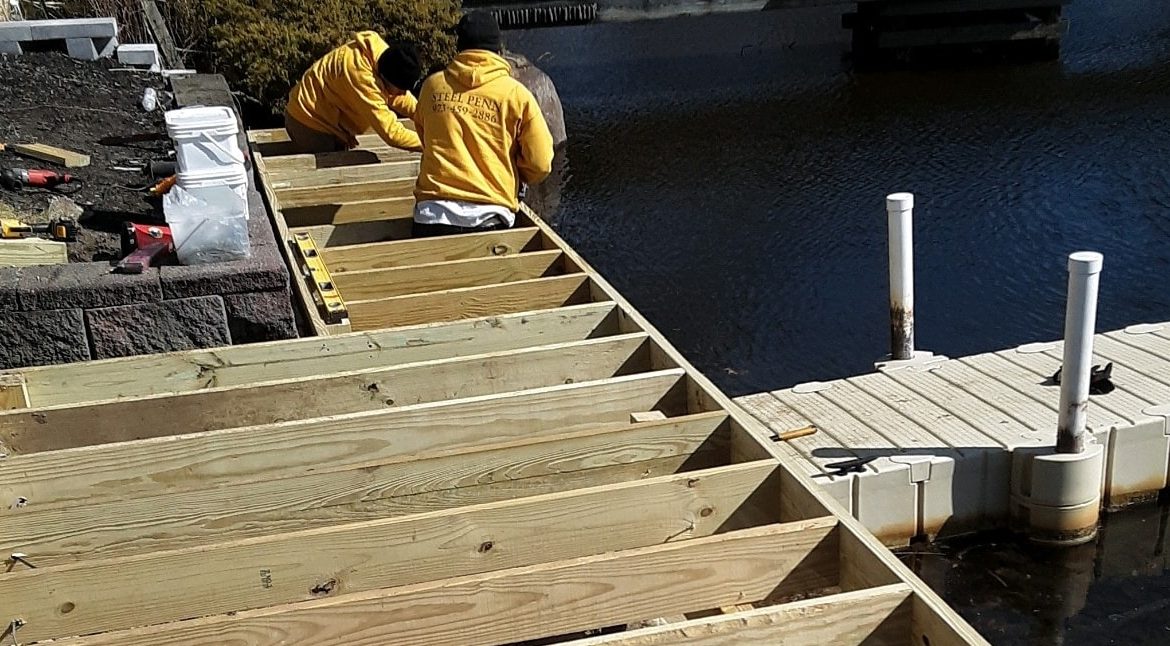Efficient Dock Repair Service Techniques: Guaranteeing Structural Integrity
Guaranteeing the architectural stability of docks with efficient repair methods is vital for the longevity and safety and security of aquatic centers. This includes a multi-faceted approach starting with extensive assessments utilizing sophisticated modern technologies like finder equipment and from another location ran lorries (ROVs) to discover both visible and concealed problems. Consequently, selecting the appropriate repair service materials, such as composite materials and corrosion-resistant alloys, is crucial for resilience. Structural support approaches, consisting of the implementation of cross-bracing systems and load-distribution plates, play a crucial function in mitigating anxiety factors. Nonetheless, the importance of these methods comes to be obvious when exploring innovative fixing methods and preventative maintenance approaches.
Evaluating Dock Damage
Examining dock damages is an important very first step in making sure the architectural honesty and security of any docking center. This first evaluation includes a comprehensive evaluation to recognize both hidden and visible damages. Key aspects to examine consist of the dock's structure, pilings, outdoor decking, and equipment. Each part must be looked at for indicators of wear, rot, corrosion, or various other forms of destruction that could jeopardize the architectural integrity.
Structural engineers or certified assessors normally perform these evaluations utilizing specialized tools and methods. For instance, underwater examinations might use sonar equipment or remotely operated lorries (ROVs) to detect submerged damage. Over water, aesthetic examinations are complemented by utilizing moisture meters and other diagnostic devices to uncover underlying issues not promptly visible to the naked eye.

Finding Repair Service Products
Picking the ideal fixing products is an essential step in the dock reconstruction process, one that directly affects the long life and performance of the fixed framework. Product choice have to be driven by factors such as ecological conditions, load-bearing requirements, and compatibility with existing dock parts.
In enhancement to wood, composite products are significantly preferred as a result of their resilience and reduced maintenance requirements. Compounds, generally made from a mix of plastic and timber fibers, supply superb resistance to rot, bugs, and UV damages. For metal anchors, selecting corrosion-resistant alloys such as galvanized steel or marine-grade light weight aluminum is important to avoid corrosion and make sure structural honesty in saline water conditions.
Epoxy resins and marine-grade sealers are important for fixing cracks and sealing joints, supplying a waterproof obstacle and boosting the dock's total stamina. By diligently selecting premium products, dock repairs can accomplish resilient results, consequently safeguarding against future degradation and making sure safe, trusted usage.
Structural Reinforcement Techniques
Reliable structural reinforcement techniques are vital in ensuring the security and durability of dock repair services. One basic approach involves using steel or composite support bars (rebar) within concrete frameworks. Rebar gives added tensile toughness, protecting against splits and dispersing lots extra equally. This approach click for info is specifically effective for anchors revealed to hefty lots or extreme ecological conditions.
One more vital method is the application of fiber-reinforced polymers (FRP) These materials supply high strength-to-weight proportions and exceptional resistance to corrosion, making them ideal for reinforcing concrete or wood docks. FRP can be used in sheets or strips and bonded with epoxy materials to improve structural stability.
Bracing and securing systems likewise play a crucial role in architectural reinforcement. Cross-bracing, making use of metal or wooden light beams, can counteract lateral forces, minimizing swaying and activity. Anchoring systems, such as helical piers or driven piles, provide a stable foundation by transferring lots to deeper, extra steady soil layers.
Last but not least, the integration of load-distribution plates can aid disperse weight much more evenly throughout the dock's surface area, alleviating local anxiety factors. These strategies collectively ensure that anchors stay risk-free and durable, with the ability of holding up against the roughness of their functional environment.
Advanced Repair Work Approaches

One more sophisticated technique entails undersea welding, which allows for repair services to be performed without the need to dewater the location. This method is especially useful for attending to structural problems in submerged dock components, guaranteeing minimal disruption to operations. Enhanced welding methods, combined with robot systems, supply precision and dependability, thus extending the lifespan of the dock.
In addition, cathodic protection systems are implemented to prevent corrosion in metallic dock structures. By utilizing sacrificial anodes or impressed present systems, these strategies properly alleviate the electrochemical procedures that cause material degeneration.
Last but not least, progressed surveillance innovations, such as architectural wellness monitoring (SHM) systems, provide real-time information on the problem of dock structures. These systems allow proactive maintenance and timely treatments, eventually making certain the long-lasting structural honesty of the dock.
Maintenance and Avoidance
Maintenance and avoidance are essential principles that underpin the longevity and safety of dock structures. Regular evaluations are extremely important, enabling very early discovery of deterioration, possible weak points, and environmental influences. A proactive technique, entailing regular checks for rust, rot, and architectural shifts, reduces expensive repair services and lengthens the dock's functional life.
Preventative procedures should include using protective finishings to metal parts to defend against rust and utilizing treated wood to withstand decay. Additionally, making sure correct water drainage and ventilation can avoid water buildup, which is a common source of architectural degradation. Incorporating quality materials and sticking to producer guidelines Find Out More throughout building and repair work stages also play critical duties in improving toughness.

Educating workers in dock upkeep finest practices makes sure consistent application of safety nets. Leveraging technological developments, such as drones for assessments and sensing units for real-time monitoring, can better enhance upkeep initiatives. By focusing on upkeep and prevention, dock proprietors can guarantee structural stability, functional security, and affordable administration over the dock's lifespan.
Conclusion
In final thought, keeping the structural stability of aquatic facilities demands comprehensive dock repair techniques. Advanced repair methods, coupled with routine upkeep practices, make sure the dock continues to be secure and operational under varied environmental problems.
Making sure the structural integrity of docks through efficient fixing techniques is extremely important for the durability and safety of marine facilities.Selecting the proper repair service products is a critical action in the dock remediation procedure, one that straight affects the longevity and performance of the repaired structure.Efficient architectural support methods are important in guaranteeing the stability and long life of dock fixings. By prioritizing maintenance and prevention, dock proprietors can make certain structural honesty, operational safety, and cost-effective administration over the dock's lifespan.
In final thought, maintaining the structural integrity of aquatic centers requires detailed dock repair strategies.